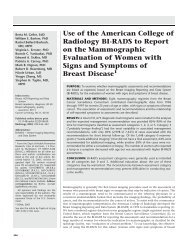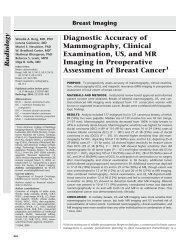Use of Microcalcification Descriptors in BI-RADS 4th ... - Quantason
Use of Microcalcification Descriptors in BI-RADS 4th ... - Quantason
Use of Microcalcification Descriptors in BI-RADS 4th ... - Quantason
Create successful ePaper yourself
Turn your PDF publications into a flip-book with our unique Google optimized e-Paper software.
BREAST IMAGING: <strong>BI</strong>-<strong>RADS</strong> <strong>Microcalcification</strong> <strong>Descriptors</strong><br />
Burnside et al<br />
The Breast Imag<strong>in</strong>g Report<strong>in</strong>g and<br />
Data System (<strong>BI</strong>-<strong>RADS</strong>) has standardized<br />
the description and management<br />
<strong>of</strong> f<strong>in</strong>d<strong>in</strong>gs identified on mammograms,<br />
thereby facilitat<strong>in</strong>g communication<br />
between radiologists and referr<strong>in</strong>g<br />
physicians. Each descriptor signifies important<br />
features <strong>of</strong> mammographic abnormalities<br />
that convey the radiologist’s<br />
level <strong>of</strong> suspicion. The standardized evaluation<br />
<strong>of</strong> f<strong>in</strong>d<strong>in</strong>gs with predictive terms<br />
enables stratification <strong>of</strong> patient risk to<br />
guide management decisions. For example,<br />
<strong>BI</strong>-<strong>RADS</strong> category 3 (“probably benign”)<br />
represents a standardized constellation<br />
<strong>of</strong> f<strong>in</strong>d<strong>in</strong>gs associated with an estimated<br />
low risk <strong>of</strong> malignancy ( 2%),<br />
which enables management that is less<br />
<strong>in</strong>vasive than biopsy but more aggressive<br />
than rout<strong>in</strong>e follow-up as the standard <strong>of</strong><br />
care (1–4). Authors <strong>of</strong> the <strong>BI</strong>-<strong>RADS</strong> lexicon<br />
also have divided microcalcification<br />
morphologic descriptors <strong>in</strong>to the follow<strong>in</strong>g<br />
designated categories that predict<br />
benignity or malignancy: (a) typically<br />
benign, (b) <strong>in</strong>termediate concern, and<br />
(c) higher probability <strong>of</strong> malignancy<br />
(5,6). Although the probably benign<br />
category is used <strong>in</strong> large prospective<br />
studies, the categorization <strong>of</strong> microcalcification<br />
descriptors <strong>in</strong> <strong>BI</strong>-<strong>RADS</strong> is<br />
based on a comb<strong>in</strong>ation <strong>of</strong> published<br />
research and the op<strong>in</strong>ion <strong>of</strong> the panel<br />
<strong>of</strong> specialists who developed the lexicon<br />
(7–11).<br />
In the past, authors <strong>of</strong> <strong>BI</strong>-<strong>RADS</strong><br />
have used cl<strong>in</strong>ical research to drive the<br />
evolution <strong>of</strong> the lexicon. For example,<br />
amorphous microcalcifications have a<br />
20% probability <strong>of</strong> malignancy, which<br />
supports the placement <strong>of</strong> amorphous<br />
microcalcifications <strong>in</strong> the category <strong>of</strong> <strong>in</strong>termediate<br />
concern (7). Investigators<br />
have identified weaknesses <strong>in</strong> the lexicon<br />
to prompt change. For example, <strong>in</strong><br />
a study <strong>of</strong> <strong>in</strong>terobserver variability <strong>of</strong><br />
<strong>BI</strong>-<strong>RADS</strong> usage (12), microcalcification<br />
descriptors were the most difficult to<br />
apply consistently between readers.<br />
Advance <strong>in</strong> Knowledge<br />
<strong>Microcalcification</strong> descriptors <strong>in</strong><br />
the Breast Imag<strong>in</strong>g Report<strong>in</strong>g and<br />
Data System <strong>4th</strong> edition help<br />
stratify the risk <strong>of</strong> malignancy.<br />
Furthermore, results <strong>of</strong> a large retrospective<br />
review (9) <strong>of</strong> biopsies <strong>in</strong>dicated<br />
that two-thirds <strong>of</strong> all microcalcifications<br />
sampled for biopsy were described as<br />
pleomorphic—a descriptor that encompasses<br />
“a broad spectrum <strong>of</strong> calcification<br />
lesions.”<br />
In response, the <strong>BI</strong>-<strong>RADS</strong> <strong>4th</strong> edition,<br />
which was published <strong>in</strong> 2003 (6),<br />
provided ref<strong>in</strong>ed microcalcification descriptors<br />
by divid<strong>in</strong>g the former pleomorphic<br />
descriptor <strong>in</strong>to two descriptors—coarse<br />
heterogeneous and f<strong>in</strong>e<br />
pleomorphic (Fig 1). Coarse heterogeneous<br />
microcalcifications (Fig 2) are “irregular,<br />
conspicuous calcifications that<br />
are generally larger than 0.5 mm” and<br />
are considered to be <strong>of</strong> <strong>in</strong>termediate<br />
concern, along with amorphous microcalcifications<br />
(6). F<strong>in</strong>e pleomorphic microcalcifications<br />
(Fig 3) “vary <strong>in</strong> sizes<br />
and shapes...usually less than 0.5 mm<br />
<strong>in</strong> diameter” and are considered to be <strong>of</strong><br />
higher probability <strong>of</strong> malignancy, along<br />
with f<strong>in</strong>e l<strong>in</strong>ear microcalcifications (6).<br />
The purpose <strong>of</strong> our study was to retrospectively<br />
evaluate whether microcalcification<br />
descriptors and the categorization<br />
<strong>of</strong> microcalcification descriptors <strong>in</strong><br />
the <strong>BI</strong>-<strong>RADS</strong> <strong>4th</strong> edition help stratify<br />
the risk <strong>of</strong> malignancy by us<strong>in</strong>g biopsy<br />
and cl<strong>in</strong>ical follow-up as reference standards.<br />
Materials and Methods<br />
Patients<br />
The <strong>in</strong>stitutional review board at the<br />
University <strong>of</strong> Wiscons<strong>in</strong> approved this<br />
study and waived the requirement for<br />
<strong>in</strong>formed consent. This study was also<br />
Health Insurance Portability and Accountability<br />
Act compliant. Our study<br />
<strong>in</strong>cluded results <strong>of</strong> 115 image-guided biopsies<br />
performed <strong>in</strong> 115 women between<br />
November 2001 and October<br />
2002 for microcalcifications deemed<br />
suspicious by radiologists. The women<br />
were 26–82 years <strong>of</strong> age (mean age,<br />
55.8 years 10.5 [standard deviation]).<br />
Results <strong>of</strong> 11-gauge stereotactic<br />
biopsies and needle localizations performed<br />
for diagnosis were <strong>in</strong>cluded.<br />
Our exclusion criteria were as follows:<br />
(a) patient’s images were not available<br />
for review, (b) calcifications were not<br />
identified <strong>in</strong> the histologic specimen,<br />
and (c) mammographic or cl<strong>in</strong>ical follow-up<br />
<strong>of</strong> at least 12 months was not<br />
performed after biopsy. The first two<br />
criteria ensured accurate characterization<br />
<strong>of</strong> the microcalcifications and appropriate<br />
correlation with the histologic<br />
f<strong>in</strong>d<strong>in</strong>gs for each abnormality. The third<br />
criterion allowed follow-up evaluation<br />
to recognize misclassification at biopsy.<br />
Of 131 consecutive patients (131 biopsies),<br />
16 were excluded (images were<br />
unavailable for 11 patients, calcifications<br />
were not identified <strong>in</strong> the histologic<br />
specimen for three patients, and<br />
follow-up was not performed <strong>in</strong> two patients),<br />
which resulted <strong>in</strong> the f<strong>in</strong>al group<br />
<strong>of</strong> 115.<br />
Imag<strong>in</strong>g and Evaluation<br />
All mammographic exam<strong>in</strong>ations were<br />
performed with dedicated mach<strong>in</strong>es. Analog<br />
mammographic exam<strong>in</strong>ations were<br />
performed with one <strong>of</strong> two units (DMR,<br />
GE Medical Systems, Milwaukee, Wis;<br />
M-IV, Lorad, Danbury, Conn) and with<br />
a screen-film technique (M<strong>in</strong>-R 2000;<br />
Kodak Health Imag<strong>in</strong>g, Rochester, NY).<br />
Digital mammograms were acquired by<br />
us<strong>in</strong>g a system with a cesium iodide–<br />
amorphous silicon detector (Senographe<br />
2000D; GE Medical Systems). Digital<br />
mammograms were pr<strong>in</strong>ted (DryView<br />
8610 pr<strong>in</strong>ter and DVB film; Kodak Health<br />
Imag<strong>in</strong>g) to be analyzed alongside analog<br />
Published onl<strong>in</strong>e<br />
10.1148/radiol.2422052130<br />
Radiology 2007; 242:388–395<br />
Abbreviations:<br />
<strong>BI</strong>-<strong>RADS</strong> Breast Imag<strong>in</strong>g Report<strong>in</strong>g and Data System<br />
CI confidence <strong>in</strong>terval<br />
PPV positive predictive value<br />
Author contributions:<br />
Guarantors <strong>of</strong> <strong>in</strong>tegrity <strong>of</strong> entire study, E.S.B., L.R.S.;<br />
study concepts/study design or data acquisition or data<br />
analysis/<strong>in</strong>terpretation, all authors; manuscript draft<strong>in</strong>g or<br />
manuscript revision for important <strong>in</strong>tellectual content, all<br />
authors; approval <strong>of</strong> f<strong>in</strong>al version <strong>of</strong> submitted manuscript,<br />
all authors; literature research, E.S.B., J.E.O.,<br />
K.J.F.; cl<strong>in</strong>ical studies, E.S.B., J.E.O., K.J.F.; statistical<br />
analysis, E.S.B., J.P.F., L.R.S.; and manuscript edit<strong>in</strong>g, all<br />
authors<br />
Authors stated no f<strong>in</strong>ancial relationship to disclose.<br />
Radiology: Volume 242: Number 2—February 2007 389





